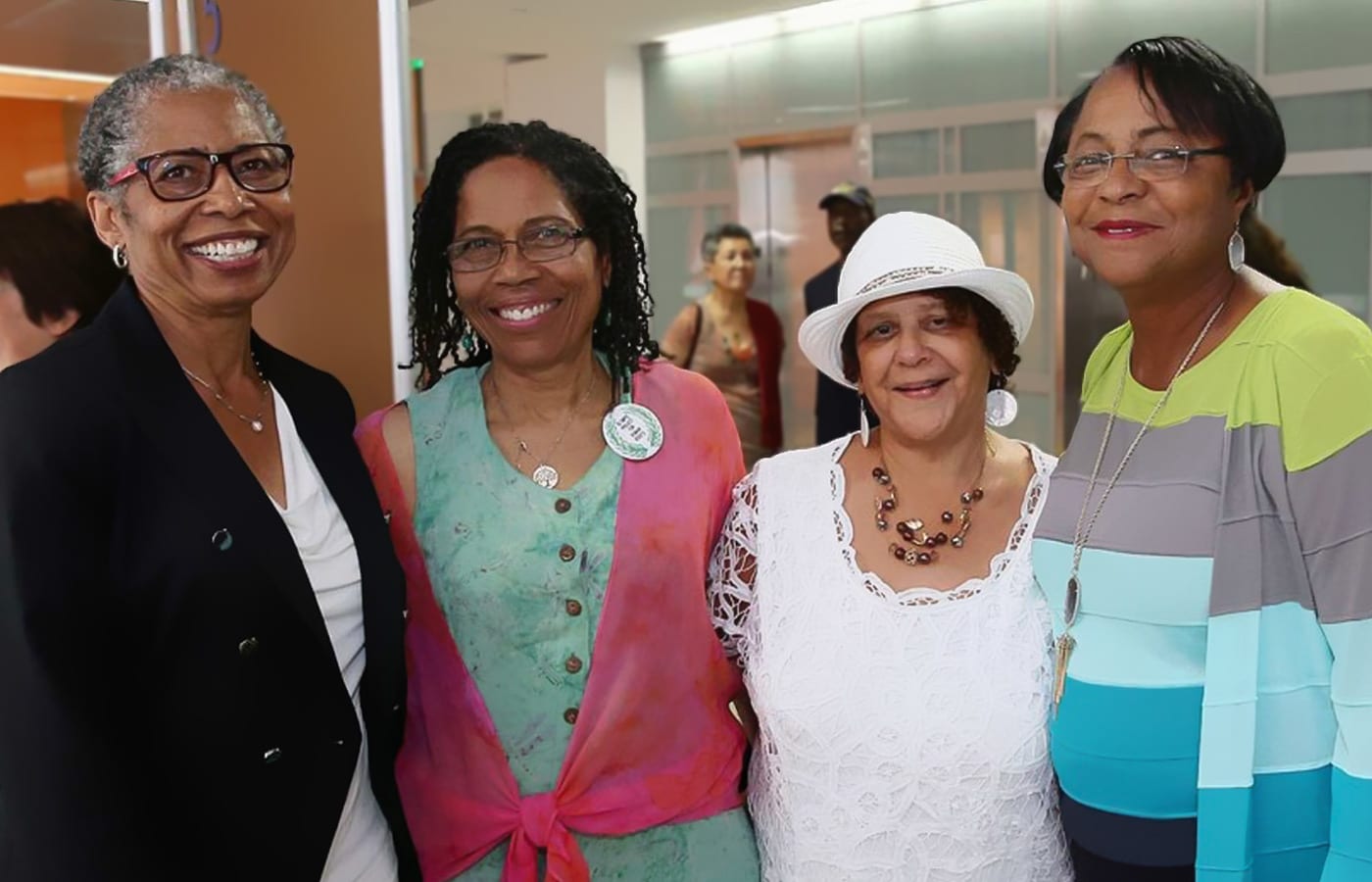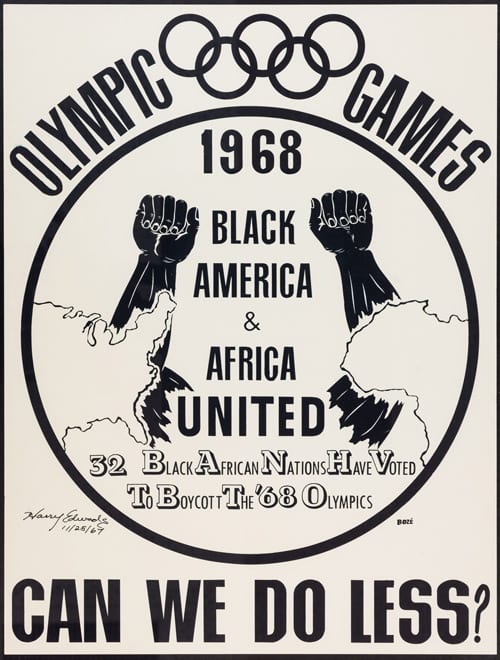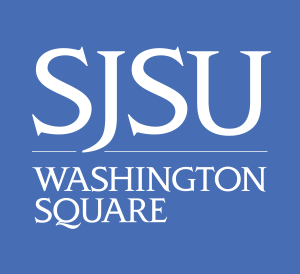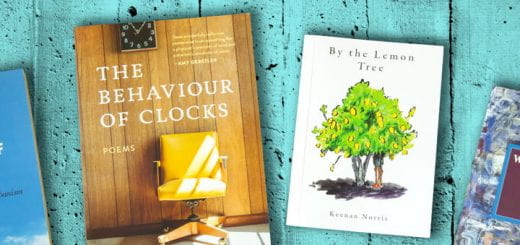The Women of the Olympic Project for Human Rights

L-R: Sandra Edwards, Gayle Boze Knowles, Rochelle Duff Davis and Mary Noel at SJSU’s 2016 commencement. Courtesy of Sandra Edwards.
Sandra Boze Edwards remembers feeling tear gas in the air during the Dow Chemical protest at San Jose State in 1967, weaving through demonstrators after class. It was only her second semester and protests against the Vietnam War and for racial justice and equal treatment of women were being staged on campus and across the country. Edwards had been exposed to the civil rights movement during her formative years in Los Angeles, in a home with politically conscious parents who had grown up in the South and migrated west when she was a child. Having watched the movement unfold across the country on the nightly six o’clock news, she was no stranger to the impact of non-violent direct action as a means for addressing injustices and even changing laws.
In fall 1967, near the end of her second semester, the aspiring teacher personally experienced how hard it was for a person of color to find housing off campus. She’d go to apartment complexes with vacancy signs in their windows, only to be told that the rooms had already been rented. She says that the political atmosphere on campus and throughout the nation was charged and full of energy. The more she learned, the clearer it became that she needed to get involved.
“Word was out about the athletes who weren’t able to get housing,” says Edwards, ’70 Social Science, Teaching Credential, ’88 MA Education Administration. “Growing up I had watched a lot of students who were participating in demonstrations in the South on TV—people I had admired. And here we had racial incidents on our own campus. I wanted to be a part of it.”
A Movement Begins

Photo: Dr. Harry Edwards Special Collection, Dr. Martin Luther King, Jr. Library Special Collections and Archives, San Jose State University.
She joined the United Black Students for Action, looking for ways to challenge housing discrimination, desegregate the Greek system and protest apartheid in South Africa—an issue that she and her father had often discussed. Edwards recruited her sister Gayle Boze Knowles and her high school friend Rochelle Duff Davis, ’71 Social Science, to matriculate at San Jose State. Davis was there from the inception of the movement. When Knowles arrived, it was in full swing. She quickly understood the movement’s immediacy and destiny, and was eager to participate. Her upbringing had, like her sister’s, been steeped in African-American history and current events. Add to that her recent one-year service in VISTA and her extensive knowledge of black literature and poetry. She was fully prepared to support the Olympic Project for Human Rights, a movement to boycott the 1968 Mexico City Olympics that united athletes around civil rights issues. Knowles, who went on to graduate from UC Irvine, is often credited with designing the OPHR poster that they distributed at track meets and around campus.
Mary East Noel also volunteered to support the cause. Noel, a teaching intern from San Francisco State, worked alongside Davis, Edwards and others with the College Commitment Program to recruit first-generation college students from underserved communities to San Jose State. Noel had relocated to California from Florida, where she had confronted the ugliness of the Jim Crow South firsthand—and was determined to change the status quo. Though not student-athletes themselves, Noel, Edwards, Davis and Knowles recognized the power of sport as a vehicle for demanding change—the tool they needed to shed light on social issues that went far beyond track and field.
“The Olympic Project for Human Rights was born out of the collaboration between two thoughtful, intellectual athletes,” Knowles recalls. “Ken Noel and Harry Edwards were recruited to San Jose State primarily for athletics. But they shared concerns about the poor conditions, specifically for black athletes at SJSU and black students in general. They saw how things had not changed much in their time at San Jose State, and they wanted to make it better for those who came after them, beginning with increased African-American access to San Jose State. And when enrolled, athlete or not, they wanted African-American students to be afforded the same dignity and support the white students were receiving.”
Messages that Matter
“At the heart of really successful movements, I think there is a level of integrity and personal accountability. I think that’s how we find our way.” —Gayle Boze Knowles
By early 1968, in their own unique ways, Knowles, Noel, Davis and Edwards had become integral parts of the OPHR movement. They responded to requests, inquiries and responses from athletes, journalists and academics—some positive, some frightening. Knowles remembers occasional phone calls in which unidentified callers shouted hateful messages before hanging up. She did not yet know that their small team would not only contribute to the movement, they would become educators themselves, carrying on the legacy of social justice throughout their personal and professional lives.
It took courage, commitment and focus on a bigger picture to take a stand for civil rights, to demand equal treatment and to simply exist as young black women in an era when even their hair was politicized. Throughout their college years, Edwards, Knowles and Noel recognized that they were treated differently, depending on how they did their hair. By embracing their natural hair, they were sending powerful visual messages of their own: We are beautiful and we are proud.
Mexico City, while a landmark moment for the OPHR, did not signify the end of the movement. Rather, it forced a public dialogue about sport and social activism, the civil rights movement at large and freedom of expression. While sociology lecturer Harry Edwards, ’64 Sociology, ’16 Honorary Doctorate, and graduate student Ken Noel, ’66 BA, ’68 MA, Sociology, strategized ways to organize student-athletes, Sandra Edwards and Davis participated in demonstrations on campus, passed out leaflets at track meets and worked in the OPHR office, managing correspondence, clipping news stories and answering their sole telephone.
When Tommie Smith and John Carlos made headlines in Mexico City, sparking international conversation and backlash, an entire community of OPHR supporters and volunteers in San Jose—many of them women—watched as the movement culminated in one iconic moment, two gloved fists raised on the Olympic podium in a human rights salute. For Edwards, the moment was both an ending and a beginning.
“It was absolutely perfect, knowing all too well the enormous pressure Tommie and John must have been under leading up to the Games, especially given their public support of the OPHR,” says Edwards. “Then they took the medal stand and we noticed the gloves and black socks. The music started, they bowed their heads and their fists came up. There they stood in this dignified stance. All of the work of so many culminated in that moment. Having witnessed what occurred on an international stage and knowing that I had contributed to that effort in some small way was extremely validating. It underscored for me at 20 years of age that you can make a difference.”
For Knowles, the moment extended the conversation that she and her friends were already having about visibility—and offered cues as to how they could multiply their impact back home.
“To me, the fist always said, ‘I’m here, I’m not going away,'” says Knowles. “We were nonviolent but we were not silent. That was the voice that comes from being seen. Nobody could dismiss or look away from the gesture. It spoke volumes. That voice said, ‘I’m here. I’m black. I’m proud. See me.’ All we were asking was to be acknowledged and recognized as human beings who deserve all the rights and privileges as every other being with white skin. Nothing has ever taken away from that loud shout that was heard around the world with that visual exclamation.”
The Legacy Continues

L-R: Harry Edwards, Sandra Edwards holding their daughter Fatima, Helen Sims, Mary Noel, Joanne Carver Dansby, Don Dansby, ‘66 BA, ‘68 MA, Sociology. Kneeling: Ken Noel, Eddie Sims. Courtesy: Sandra Edwards.
Inspired by the impact they had helped make and motivated to create opportunities for the next generation, Davis, Edwards and Noel became teachers, principals and educational administrators. Knowles led a successful career as a technical writer before becoming a teacher herself. The OPHR had taught them that education was the key to empowering others—and that every child deserved a seat at the table, regardless of race, class or gender.
“All my life, I wanted to open doors for black students to get an education,” says Noel, ’99 MA Education, Educational Administration Credential. “I wanted to be someone who tells kids, ‘You can go to college.’ That’s still my mission today.”
Fifty years have passed since that iconic day in Mexico City. Noel, Knowles and Edwards recognize the sacrifices made by Linda Evans, Denise Pascal and Kim Carlos—then wives and partners of Olympians Lee Evans, Smith and Carlos—whose support contributed to the success of the OPHR. The medal stand salute communicated so much of what they were feeling—of what they were confronting—in San Jose, in their hometowns and in the communities where they worked.
Edwards, Noel and Knowles are mothers and grandmothers, friends who have shared many personal and professional milestones throughout the years. In their own ways, each of them has found ways to add the OPHR ethos to their lives. Noel serves on the Oak Grove School District school board. Knowles worked tirelessly to get out the vote for Barack Obama when she lived in New Mexico and championed the traditions and students she taught on the Navajo Reservation there. Upon retirement, Edwards became a court-appointed advocate for children in foster care, as well as an adjunct professor at Santa Clara University, where she taught educational equity and diversity classes for aspiring school administrators. She continues to be an active supporter of the Institute for the Study of Sport, Society and Social Change, San Jose State’s home for academics, students and sport sociologists. She has never forgotten the impact that a single moment can make—and the number of people working hard behind the scenes to create a movement.



